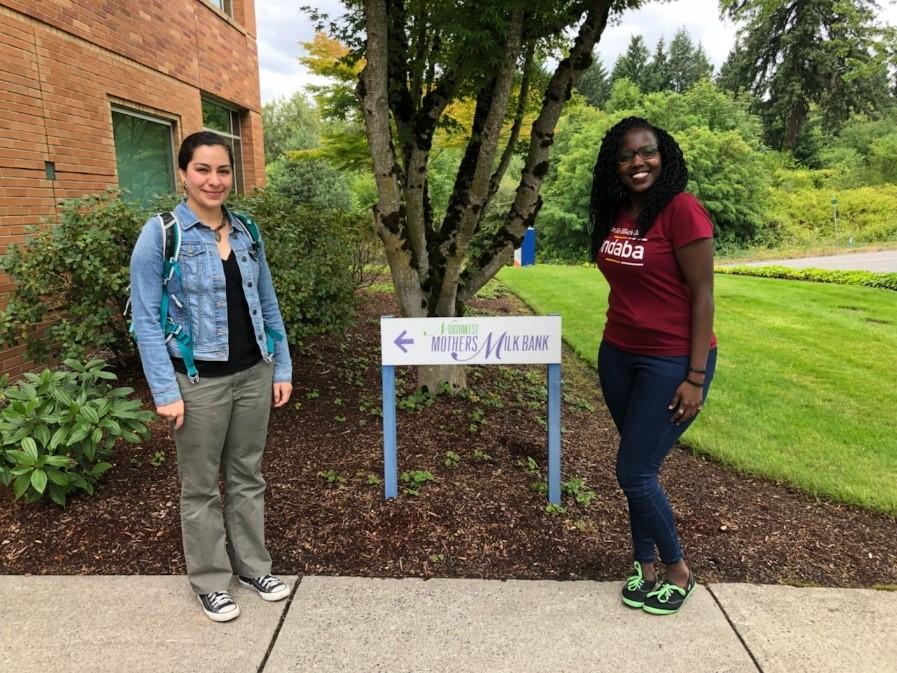By Brenda Kharono and Miriana Duran
August 1-7 is World Breastfeeding Week. In a world filled with inequality, crises and poverty, breastfeeding is the foundation of lifelong good health for babies and mothers. To highlight these issues, UW Global Health MPH students Brenda Kharono and Miriana Duran share their experiences researching human milks banks.
Human breast milk is proven to reduce the risk of disease and death among premature babies and infants born with very low birth weights. Yet there are myriad circumstances in which babies may not have access their mother’s own milk. These include premature babies whose mothers haven’t started producing sufficient milk volume, infant abandonment, mother’s death or disease.
Universal access for babies to human milk remains a huge challenge in the U.S. and around the globe. Are there options for babies with no access to their own mother’s milk and mothers who want to breastfeed but face lactation challenges?
Brenda Kharono, a medical doctor from Uganda, and Miriana Duran, a medical doctor from Mexico, are Department of Global Health graduate students at the University of Washington. Together they are investigating the challenges and solutions to improving babies’ access to human milk and lactation support in health systems as part of their studies, with support from Global WACh and PATH.
As part of their summer internship at PATH, Brenda and Miriana visited The Northwest Mothers Milk Bank in Portland, Oregon, a nonprofit organization that aims to promote, protect and support breastfeeding, and provide breastmilk to local babies in need.

“As a doctor, I see how empowering and motivating it is for women to give lifesaving nutrition to the most vulnerable babies. Yet I also know that many babies have no access to human milk. Our visit to the Portland milk bank drew us deeper into the challenges many families face in accessing breast milk for their infants,” says Brenda Kharono, “I wanted to learn about the alternatives for babies with no access to their own mother’s milk, and what mothers who want to breastfeed their babies but who faced lactation challenges can do. Also, what are options for babies in neonatal units who can’t tolerate baby formula.”
With a mission to improve the health and survival of the Northwest’s most vulnerable babies, The Northwest Mother’s Milk Bank (NWMMB) supplies donor human milk to 65 Neonatal Intensive Care Units across the Pacific Northwest. One of its key pillars is to protect, promote and support breastfeeding by providing safe, high-quality donor milk for those who don’t have access to their mother’s own milk. Processes and steps that donated human milk goes through to make it suitable for donor recipients include rigorous screening of all donors, and compliance with pasteurization and storage guidelines from Human Milk Banking Association of North America (HMBANA). These steps include milk categorization into batches, procedures for thawing before being pasteurized, testing for pathogens, and storage and monitoring procedures.
“Although excellent procedures, such as those from HMBANA, offer guidance to milk banks, we learned there are still a number of challenges to making safe donor milk available globally. These include a lack of global guidance, such as from the World Health Organization, on optimal human milk banking practices in various contexts,” says Brenda.
“There is also a lack of awareness around existing human milk banks, and how they function. This happens at many levels, from pregnant mothers to health care providers,” says Miriana, “For example, medical doctors and nurses around the world receive little education about breastfeeding, which does not often include education on human milk banking. Additionally, many donor mothers, especially in the US, need a physician/clinician approval to donate breast milk, however, health care providers are unaware of the ways that mothers can safely donate human milk.”
The research led to the overall conclusion that more strategic efforts are needed to harmonize health care provider involvement in provision of lactational support and potential breast milk donation. Tools such as those from the PATH Human Milk Bank project, which is creating templates, tools and resources for human milk banking, fill a gap, making human milk banking information more accessible both locally and internationally.
“We can save children’s lives by using another breastfeeding mom’s milk - but to achieve this we must increase access to human milk for all infants, ” says Brenda.
To donate milk, volunteer, or learn more about the work The Northwest Mothers Milk Bank, see www.donatemilk.org. The authors are thankful to The Northwest Mothers Milk Bank, PATH, and all the staff members and donor women that have made our work possible.